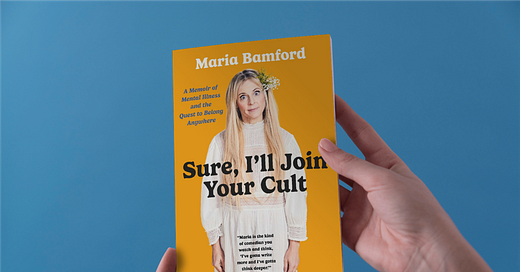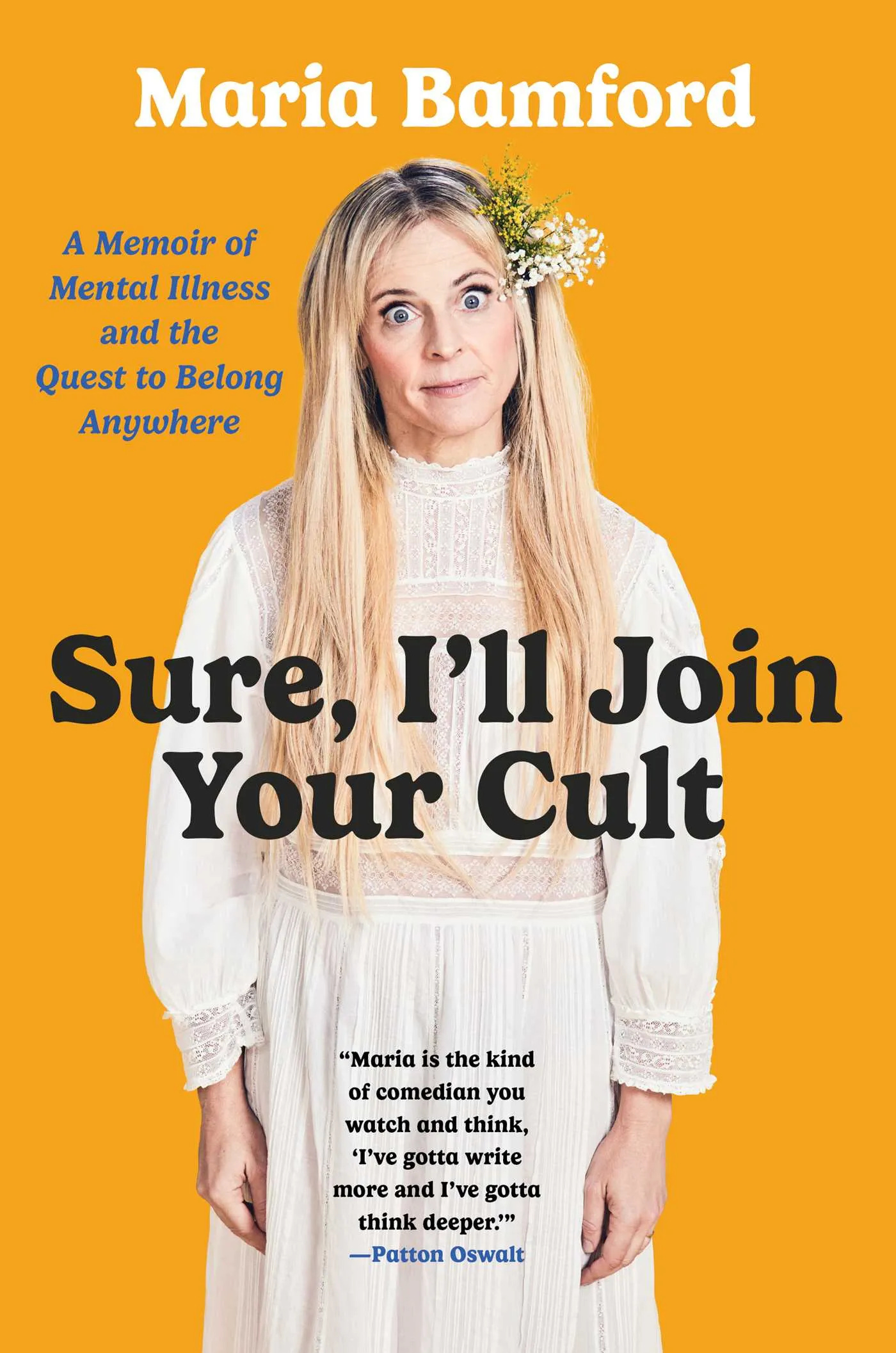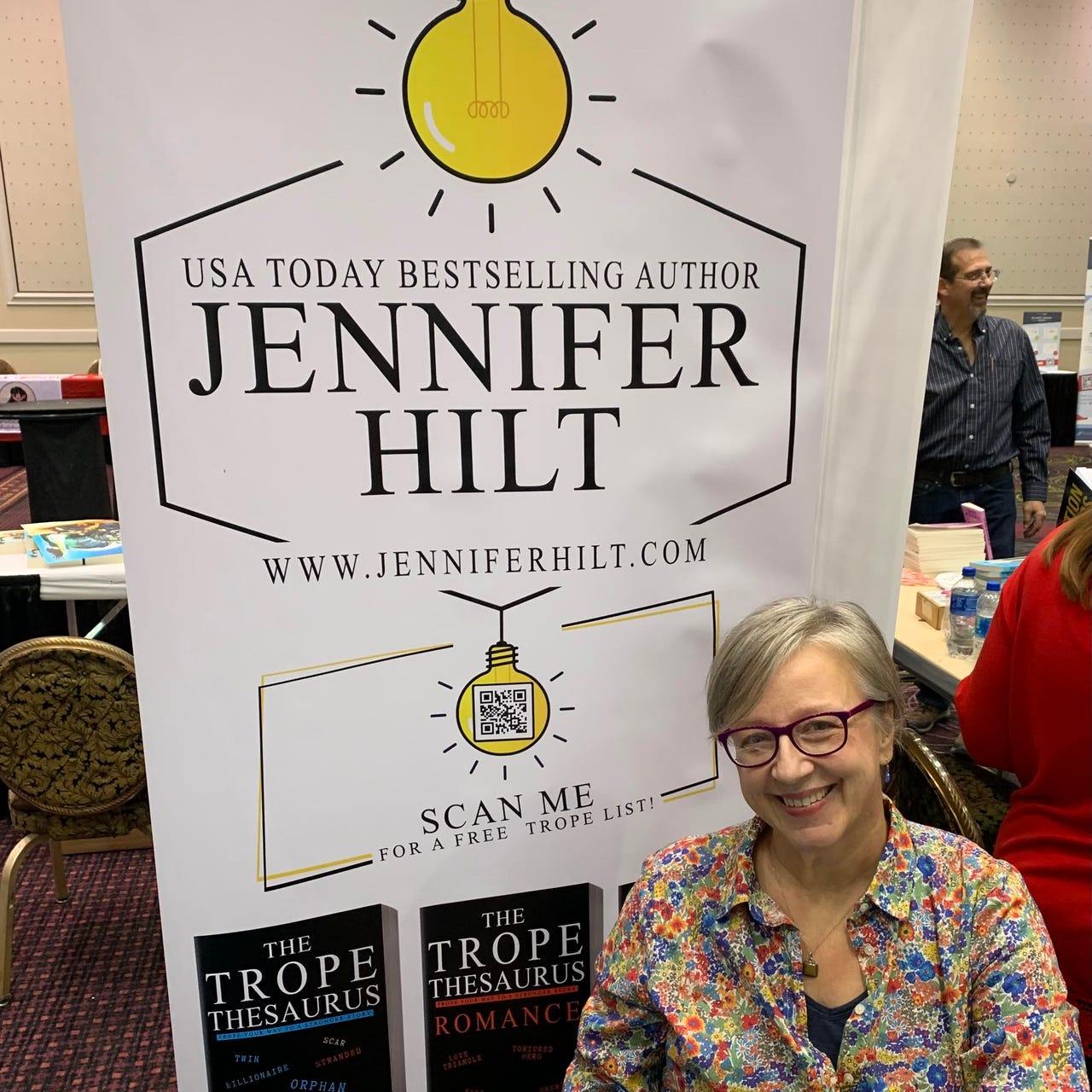Memoirs have tropes?! Trope lessons from Maria Bamford's Sure, I'll Join Your Cult
In praise of Maria Bamford's Sure, I'll Join Your Cult's use of tropes to develop an effective message around your memoir and bring your readers into the story quickly.
Memoirs are challenging for storytellers. They offer enhanced life experiences, but they also need to be somehow relatable. The stakes are high. How do you describe a particular life experience and include the reader?
Use tropes. This shouldn’t be a huge surprise, given my trope fixation. All stories have tropes. Some are more developed than others. Some are twisted and combined in fresh ways.
Still, when I say tropes are everywhere, what I mean is just fiction, right? Nope.
Nonfiction is loaded with tropes, too.
I've been a fan of comedian Maria Bamford for over a decade, so picking up her 2023 memoir Sure I’ll Join Your Cult was an easy sell. Maria is an actress and comic who has appeared in Arrested Development and Lady Dynamite. Having seen her live shows no less than five times, I’m a fan.
Like David Sedaris, Bamford looks unflinching at her life, family, and mental health. And because she is a gifted storyteller, I’m sucked into her story. But let’s take a look at how she crafted her memoir. Here is the blurb from the book so we’re all on the same page. [ed. note: For reference, everything bolded in italics in this piece is a quote from the book, which you can buy here.]
From “weird, scary, ingenious” (The New York Times) stand-up comedian Maria Bamford, an instant New York Times bestselling, brutally honest, and “laugh-out-loud funny” (Jennette McCurdy, #1 New York Times bestselling author) memoir about show business, mental health, and the comfort of rigid belief systems—from Dale Carnegie’s How to Win Friends and Influence People, to Richard Simmons, to 12-step programs.
Maria Bamford is a comedian’s comedian (an outsider among outsiders) and has forever fought to find a place to belong. From struggling with an eating disorder as a child of the 1980s, to navigating a career in the arts (and medical debt and psychiatric institutionalization), she has tried just about every method possible to not only be a part of the world, but to want to be a part of it.
In Bamford’s “trademark blend of disarming intimacy and dark whimsy” (Publishers Weekly), Sure, I’ll Join Your Cult brings us on a quest to participate in something. With sincerity and transparency, she recounts every anonymous fellowship she has joined (including but not limited to: Debtors Anonymous, Sex and Love Addicts Anonymous, and Overeaters Anonymous), every hypomanic episode (from worrying about selling out under capitalism to enforcing union rules on her Netflix TV show set to protect her health), and every easy 1-to-3-step recipe for fudge in between.
Packed with “Bamford’s brilliance, relentless humor, and insatiable instinct for survival (Library Journal), this memoir explores what it means to keep going, and to be a member of society (or any group she’s invited to) despite not being very good at it. In turn, she hopes to transform isolating experiences into comedy that will make you feel less alone (without turning into a cult following).
Memoirs are often structured chronologically, which makes sense in recounting a life. But Bamford takes a different approach.
This book is not going to have a clear chronicle of trauma, healing, victory…I don’t relate well to stories where people have found some sparkling new reality at the end of the memoir.
Her memoir is structured around the theme of cults. As a topic, mixing memoirs and cults is pretty popular.
Bamford frames her quest to create a found family for herself as a cult journey.
She hooks us into her search for meaning in her life by participating in various cults, which she defines as a social group defined by its unusual philosophical beliefs. And she structures the memoir into three sections: 1). early cults (i.e., family), 2). cults around fame, and 3). cults regarding mental health.
Cults as family
If our family was a cult and we had a leader, our leader was my mom, Marilyn. She was beloved and charismatic, and inspired intense devotion.
One of Maria's core themes is her lifelong quest for approval from her mother.
Let’s look at one of Bamford’s early examples of managing conflict with her mother. Bamford’s eleven-year-old self had a pretty clear goal, motivation, and conflict after suffering in secret about repetitive violent thoughts for over a year.
Goal: Receive verbal reassurance from her mom so she can sleep
Motivation: Unable to sleep because of compulsive thoughts, a fifth-grade Maria visits her mom
Conflict: Her mom misunderstands Maria's need for reassurance, causing her more anxiety
Bamford's relationship with her mother is complicated. And guess what? Many humans have complicated relationships with their mothers. I've never suffered from an eating disorder like Bamford has, but I appreciate trying to be heard by my family. Also, as a parent, I empathize with her mother because sometimes you need the kids to go to bed.
Since Bamford often felt like an outsider (loner) in her own family. She tried to please her mother (boss) by playing the violin (profession) for years, although she hated it. She told stories at dinner engagingly to rival her older sister (family, politics). And she exercised for hours (secret) to lose any weight she gained (ugly duckling, scar).
Even as a fifty-year-old adult, Bamford never stopped trying to gain her mother’s approval, I nagged a mortally ill woman for additional recognition after her seventy-six years of service.
While our experiences aren’t the same, the feelings generated by her relationships are something readers can share—that is a trope doing its job.
Cults around fame
I want belonging in a thing but I won’t want any of the responsibilities inherent in claiming association.
Goal: Be a stand-up comedian
Motivation: Make a living and acquire enough money to pay for food and resources
Conflict: Being a career stand-up comedian is very difficult
Bamford’s mental health impacted her ability to support herself (family, politics). Her parents supported her for many years, but eventually, she worked many temp jobs (professional). Because of her impaired decision-making from her untreated mental illnesses, she developed debts (the con). Managing her mental health, finding work as a comic, and supporting herself was an ongoing struggle (quest). She’d gain a job only to lose it through self-sabotage (loner, scar, secret). She joined more 12-step groups (found family), trying to control her life (forced proximity). She became more successful as a comic while adding some acting and voice-over work (profession). However, her mental health suffered with inconsistent treatment and the severity of her diagnosis (victim).
As you can imagine, the type of addiction colors the vibe of the group. AA is rowdy, like a party or a bar---lots of joshing and camaraderie. Overeaters Anonymous is mostly quiet types who would rather be alone with a turtle sundae or a roasted chicken. Al-Anon (for family and friends of addicts is high-strung; there are tons of formatted readings and mutually managed control freaks. Debtors Anonymous has a business seminar feel, and they use parliamentary procedure to decide what kind of bagels to serve at the meeting. A SLAA (Sex Love Addicts Anonymous) meeting looks like when the lights come on at the end of a the night at the club. It is filled with buzzy, intense people in tight clothes.
Bamford's dilemma of wanting to be included but not being responsible is another common human emotion. We are all busy and burdened enough not to want to take on more. Or, in the words of my neighbor Natasha, who I refer to as The Oracle, nobody wants to do more than they have to. Wouldn't it be nice to be accepted without putting more effort in?
Cults around mental health
Everyone wants you to get better, but they don’t know what medication is going to work. I think that’s like most illnesses/school courses/human relationships. No one can guarantee security and stability, which is a real bummer when you think about it. Don’t think about it.
Goal: Stabilize her mood
Motivation: Be able to function/do her work
Conflict: She’s having a psychotic episode
After Bamford’s beloved dog died, she blamed herself (scar). That, plus an increasingly hectic work schedule, necessitated her being hospitalized (forced proximity, violence) on three separate occasions (forced proximity, ticking time bomb).
Scars and secrets are the bread and butter of the memoir. We may not share the same ones as the author, but we all have them. It's part of being human. Tap into those tropes deeply enough that others can experience those emotions is the work of great storytelling.
Thanks so much for reading. If you liked this one, make sure to find me on my Substack, where I do even deeper on tropes.
If you saw value here, I hope you’ll consider becoming a paid member to help foster more of this type of thing. As a member, you’ll get access to over 600 exclusive posts, including books, courses, lessons, lectures, fiction books, and more, or you can give us a one-time tip to show your support.










Your Trope Goddess comment makes my day! ❤️
I’m so glad it’s helpful! Secret and scar as foundational tropes for memoir gives lots of opportunities to combine with other tropes too.